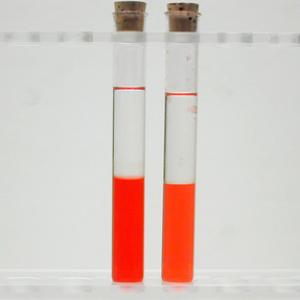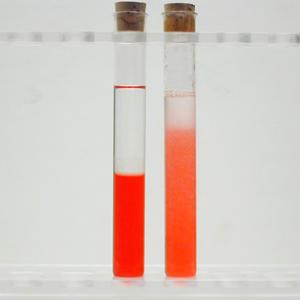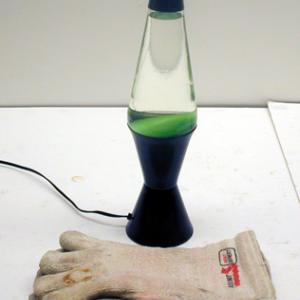College of Liberal Arts & Sciences
2B40.55 - Particle Diffusion In Stellar Medium - Percolation & Convection Cells
See also 2B40.55 in Heat and Fluids, 4B20.50 in Heat and Fluids, and 8B10.40 in Astronomy.
Fill three test tubes half full of colored water, and put baby or mineral oil in the other half. In one of the tubes put 1 or 2 drops of soap. Use one of the half and half mixtures as a reference. Take the other half and half mixture and the tube with the soap and shake vigorously. Put them back in the holder and watch the percolation type separation, and the time differences.
Turn on the lava lamp at least 2 hours before demonstration time. When the lamp reaches normal temperatures convection cells may be observed. These convection cells are basically isolated regions that have gained heat and therefore changed their density. When heated it will rise until it cools off significantly. When it cools the density increases and it starts to sink.
Note that the action of the lava lamp is chaotic and can be used for chaotic formation demonstrations if desired.
- Zachary H. Levine, "Separation of Peas and Carrots in Boiling Water", TPT, Vol. 59, #8, Nov. 2021, p. 643.
- Gustavo Ariel Schwartz and Silvio J. Ludueña, "An Experimental Method for Studying Two-Dimensional Percolation", AJP, Vol. 72, #3, Mar. 2004, p. 364.
- Charles Vivian, "A Liquid Sandwich", Science Experiments & Amusements For Children, p. 83.
- Yaakov Kraftmakher, "7.13, Percolation", Experiments and Demonstrations in Physics, ISBN 981-256-602-3, p. 479.
- Janice VanCleave, "9, Recover", Engineering For Every Kid: Easy Activities That Make Learning Science Fun", p. 67.
- Janice VanCleave, "Immiscible", Chemistry for Every Kid - 101 Experiments That Really Work, p. 168 - 169.
- Janice VanCleave, "Riser", Guide to More of the Best Science Fair Projects, p. 90.
- Tik L. Liem, "Make Milk From Water and Oil", Invitations to Science Inquiry - Supplement to 1st and 2nd Ed. p. 37.
- Borislaw Bilash II, “Separating Immiscible Liquids“, A Demo A Day – A Year of Physical Science Demonstrations, p. 44.
Disclaimer: These demonstrations are provided only for illustrative use by persons affiliated with The University of Iowa and only under the direction of a trained instructor or physicist. The University of Iowa is not responsible for demonstrations performed by those using their own equipment or who choose to use this reference material for their own purpose. The demonstrations included here are within the public domain and can be found in materials contained in libraries, bookstores, and through electronic sources. Performing all or any portion of any of these demonstrations, with or without revisions not depicted here entails inherent risks. These risks include, without limitation, bodily injury (and possibly death), including risks to health that may be temporary or permanent and that may exacerbate a pre-existing medical condition; and property loss or damage. Anyone performing any part of these demonstrations, even with revisions, knowingly and voluntarily assumes all risks associated with them.


